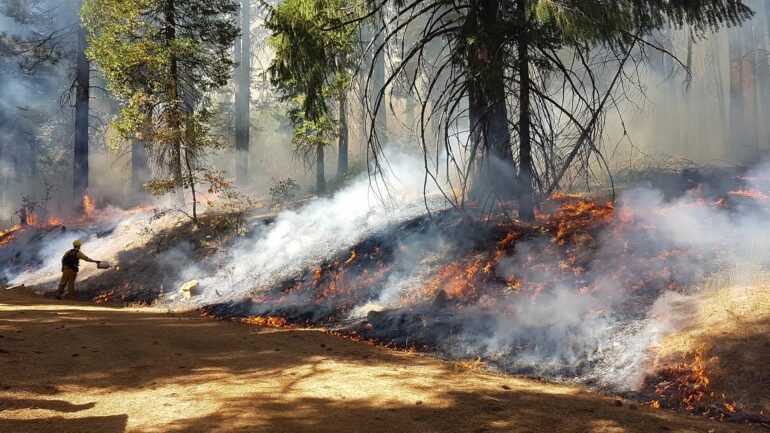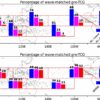Across the American West, managers of fire-prone landscapes are increasingly using a practice that seems counterintuitive: setting small fires to prevent larger, more destructive ones. Commonly called “prescribed burns,” these targeted, controlled fires keep forests healthy by reducing the buildup of grasses, leaves, branches, and other debris that can fuel larger wildfires and smoke out nearby communities.
But smoke from prescribed burns also presents health risks. Today’s forest managers must ask themselves—how much prescribed burning is too much? When do the long-term benefits of fuel reduction no longer outweigh the short-term smoke costs? And how can nearby communities better prepare for a fire season?
An international team led by researchers at the University of Washington built a framework to help land managers assess the air quality implications of land management scenarios with different levels of prescribed burning. To apply the framework, researchers linked together a series of models that estimate the smoke effects of various levels of prescribed burning on ecosystems and nearby communities.
After using those models to estimate the smoke produced under six different levels of prescribed burning across California’s Central Sierra range, the researchers found that moderate amounts of burning would reduce overall smoke levels. All tested levels of prescribed fires led to less wildfire smoke overall. But greater amounts of prescribed fires could present notable health hazards of their own.
The researchers reported their findings—specific to the Central Sierra landscape—in a pair of papers. The first, published Dec. 27 in Nature Sustainability, estimated how different levels of prescribed burning affected the total amount of smoke produced during an average wildfire season. The second, published Jan. 16 in Environmental Research Letters, analyzed the impacts on the region’s outdoor agricultural workers.
“We haven’t had a good way to put numbers to that smoke exposure trade-off previously because of challenges in integrating data and methods across sectors,” said Claire Schollaert, a UW doctoral alum of the Department of Environmental & Occupational Health Sciences and lead author of both papers. She is now a postdoctoral scholar at UCLA.
“We know that if we can reduce fuel density, then wildfires may be less severe when they do come through. Emissions may also be lower, and thus subsequent smoke exposure and health impacts will be less. We also must consider that the location and timing of prescribed burns are planned, which is not the case for wildfires. That’s the concept. But I think communicating that has previously been difficult.
“What’s cool about this work is we were finally able to quantify the trade-off between reducing wildfire risks and its impacts on human health through prescribed burning at a local scale.”
Researchers focused on the Tahoe Central Sierra Initiative, a 2.4 million acre expanse covering public, private and commercial land. A consortium of land managers in the area developed six forest management scenarios with increasing levels of prescribed burning. They ranged from Minimal Management, with no prescribed burns and limited efforts to trim back excess fuels, to a scenario dubbed Fire++, with an estimated 30,000 acres of prescribed burning each year.
Those scenarios were fed into a series of models that estimated the amount of smoke generated by wildfires and prescribed burns in each scenario, and the health impacts on nearby communities.
Every scenario that included prescribed burning in the Tahoe Central Sierra Initiative resulted in a shorter wildfire smoke season, with less overall smoke, than those without prescribed burns. As a result, nearby communities and outdoor agricultural workers could be exposed to less smoke.
The model predicted that overall smoke levels as measured by concentrations of fine particles (PM2.5) were lowest with a moderate amount of prescribed burning—a scenario researchers called, simply, Fire. Scenarios that involved greater amounts of burning—Fire+ and Fire++—produced slightly more total smoke than the moderate scenario.
Schollaert hopes forest managers across the country will replicate the methods, so they can better incorporate public health considerations into management planning on their specific landscapes.
“The exact placement of that sweet spot of prescribed burning is going to vary. But when mitigating extreme wildfire risk, the more you can lower severity of fire, the lower your emissions are going to be, generally,” Schollaert said. “And baked into that sweet spot is also coordination with health agencies, because you can theoretically plan for smoke from prescribed burns. That’s the kind of planning I’m hoping can come from this.”
More information:
Claire L. Schollaert et al, Quantifying the smoke-related public health trade-offs of forest management, Nature Sustainability (2023). DOI: 10.1038/s41893-023-01253-y
Claire L Schollaert et al, Estimated impacts of forest restoration scenarios on smoke exposures among outdoor agricultural workers in California, Environmental Research Letters (2023). DOI: 10.1088/1748-9326/ad16a4
Provided by
University of Washington
Citation:
Research helps California forest managers assess smoke hazards from prescribed burns (2024, January 17)



